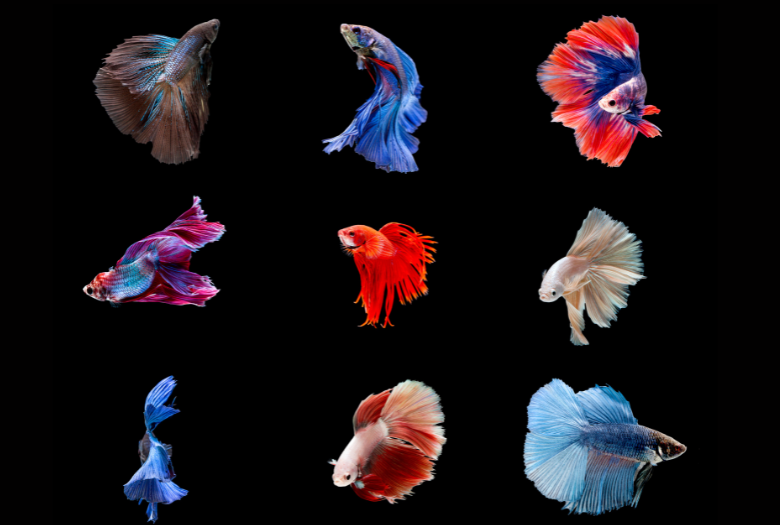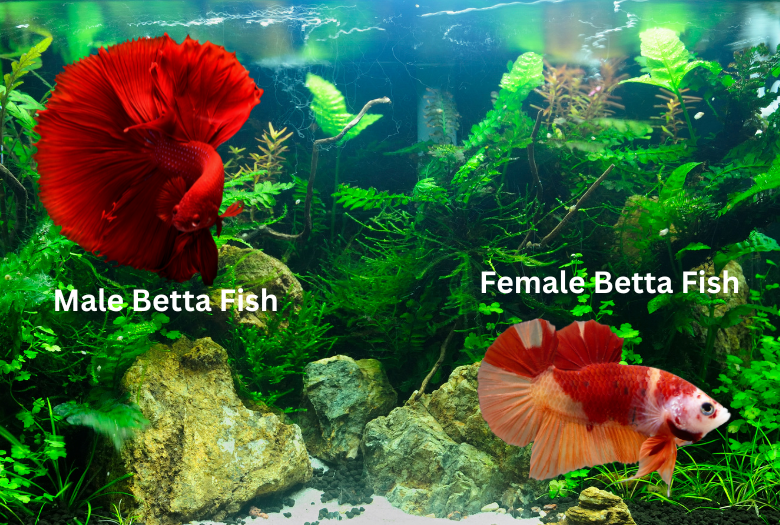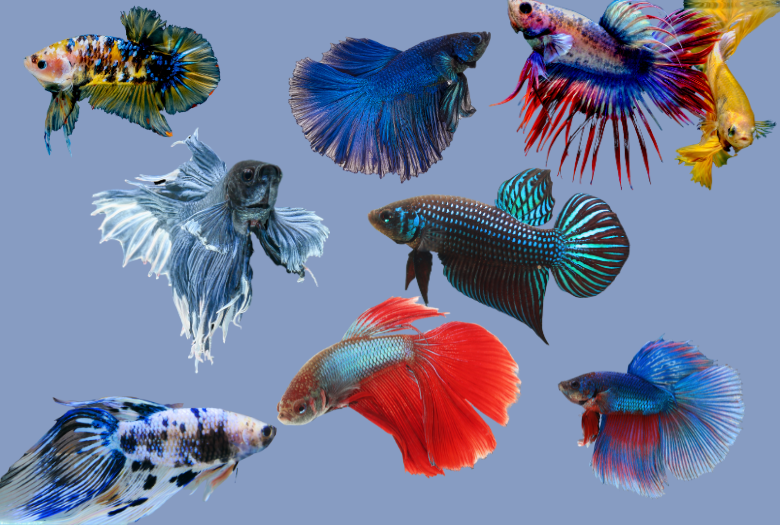Finding the Ideal Betta Fish
Siamese fighting fish, often known as betta fish, are prized for their stunning colors, graceful fins, and endearing personalities. A vital first step in finding the ideal betta fish is knowing what you’re looking for, and the parameters in which they will be happy and healthy in your tank.
This article will examine the selection of a Betta fish, outlining the variables to consider, including activity level, physical condition, gender, color, and tail type. Prospective Betta owners may make an educated choice and select the ideal aquatic friend by being aware of these factors.

Finding the Ideal Betta Fish:
Active,
vibrant, and wholesome...
It is crucial to pay attention to a Betta fish's behavior, looks, and general health while choosing one. Active Bettas swim vigorously and curiously investigate their environment.
They are an interesting addition to any aquarium because of their alert and lively nature. Look for fish that actively interact with their surroundings and exhibit evidence of energy and health.
Betta fish come in a broad range of colors, from vivid shades of red, blue, and green to uncommon color schemes like marble or butterfly designs. Selecting a Betta with colors that are meaningful to you personally will increase how much you enjoy being around them.
It is important to keep in mind that the color intensity might fluctuate between juvenile and adult Bettas and also depending on the illumination.
The eyes of a healthy Betta fish should be unclouded and bulge-free. There should be no lesions or indications of discoloration on the scales; they should be smooth and undamaged.
It is suggested to stay away from people with torn or frayed fins since they may be unhealthy or under stress. Similar to this, be wary of fish that display symptoms of disease, such as loss of appetite, lethargic behavior, or unusual swimming patterns.
Choose Betta fish with strong physical qualities and a lively personality.
 Betta Fish Features
Betta Fish FeaturesFinding the Ideal Betta Fish:
Betta, male and female...
It's crucial to think about each Betta's particular traits while choosing between a male or female. Long, flowing fins of male Bettas are well known for their stunning aquatic displays.
Compared to women, they often have more vivid colors. They are popular options for enthusiasts looking for an aquarium centerpiece because of their majesty and beauty.
In contrast, female Bettas have shorter fins and tend to be less aggressive than males. They have a more streamlined look, emphasizing overall sleekness over showy finnage.
Female Bettas may live happily in groups as long as the tank is big enough and set up correctly to support their social dynamics.
The choice of a male or female Betta ultimately comes down to personal taste and the objectives of your aquarium. A male Betta could be the best option if you're looking for a lone, eye-catching fish.
As an alternative, a group of female Bettas may form a vibrant and intriguing aquatic community if you're interested in examining the interactions and social dynamics of different fish.
 Male and Female Betta Fish
Male and Female Betta FishFinding the Ideal Betta Fish:
Considerations
for Tail Type and Color...
Prospective owners have a wide variety of choices because to the wide variety of colors and tail styles that betta fish come in. With variants that may trigger feelings, meet individual aesthetics, or go well with the overall tank decor, the color pallet of Betta fish is astounding.
There is a Betta fish to fit every preference, whether you want striking reds, captivating blues, or distinctive patterns.
The kind of tail is still another important factor in addition to color. Different tail varieties affect the swimming skills of Bettas as well as their aesthetic attractiveness.
The plakat, halfmoon, crown, and veiltails are some of the most popular varieties of tails.

Finding the Ideal Betta Fish:
Creating
the Best Environment...
The general health and happiness of your Betta fish depends on the environment you provide. The size of the tank, water temperature, filtration, decorations, and water conditioning are all important considerations while putting up a Betta aquarium. The fundamental components of setting up a Betta tank will be covered in this article, along with explanations of their significance and tips for creating a favorable habitat for your cherished aquatic friend.
Choosing the Right Tank Size:
Choosing the proper tank size is essential to giving your Betta fish a cozy place to live. Although a 5-gallon minimum tank size is advised, bigger tanks have greater advantages. Greater water volume from a bigger tank aids in toxin dilution and stable water parameters. Additionally, having a large swimming area helps your Betta behave naturally and decreases stress.
Due to fewer filters and higher waste accumulation in a smaller tank, water quality might degrade more rapidly. This may have a negative impact on health and need more regular water changes. Therefore, choosing a tank bigger than the minimum advised size is essential for making sure your Betta fish have a healthier and more pleasurable home.
Upkeep of Water Temperature:
Tropical fish species that are native to warm waters include betta fish. The water temperature must be kept between 76 and 82 degrees Fahrenheit (24 and 28 degrees Celsius) in order to mimic their native habitat. Your Betta tank set up needs a dependable heater to provide a consistent and cozy temperature for your fish.
In order to efficiently control the water temperature, get a heater with an integrated thermostat. The fact that submersible heaters may be put covertly within the tank makes them a popular choice. To ensure that the warmth is distributed uniformly throughout the tank, it is best to install the heater close to the water flow, such as at the filter outflow. Use a trustworthy thermometer to consistently check the water's temperature to make sure it stays within the advised range.
Putting in Place an Effective Filtration System:
For the health and lifespan of your Betta fish, maintaining proper water quality is essential. A good filtration system helps keep the tank clean and livable by removing extra waste, pollutants, and debris. The Bettas love mild water flow, so it's necessary to use a filter with adjustable flow or to build baffles to lessen water movement.
For Betta tanks, sponge filters or hang-on-back (HOB) filters with adjustable flow settings are common options. Betta fish may be kept in sponge filters because they provide biological filtration while causing the least amount of water disturbance. To produce a gentle current, HOB filters with adjustable flow may be adjusted to a lower level. To keep the filter media effective, regularly clean it or replace it as the manufacturer instructs.
Decorating to Create a Stimulating Environment:
In order to provide your Betta fish a visually attractive and exciting habitat, decorations are essential. They also provide practical functions, including providing surfaces and hiding places for healthy bacterial growth. Think about using real plants, such Java fern or Anubias, which not only improve the visual appeal but also improve your Betta's general wellbeing.
Your Betta may relax, explore, and create bubble nests on live plants. By absorbing nitrates and supplying oxygen, they also aid in maintaining the quality of the water. If you want low-maintenance solutions, consider using silk or soft plastic plants. Include decorations like ceramic buildings or caverns to provide hiding places and to resemble natural environments. To avoid hurting your Betta's sensitive fins, make sure all decorations are smooth and devoid of rough edges.
Water monitoring and treatment:
For your Betta fish to live in the best possible circumstances, regular monitoring and tank water conditioning are crucial tasks. Follow these crucial procedures to preserve water quality and get rid of dangerous chemicals:
First, use a liquid test kit to routinely examine the water's properties. You'll be able to see any possible problems and take the necessary action by keeping an eye on metrics like ammonia, nitrite, and nitrate levels. Nitrate concentrations should be kept below 20 ppm, whereas ammonia and nitrite concentrations should ideally be nil. At least weekly water tests should be performed, or as directed by the test kit's instructions.
Second, if you replace the water in the tank or add fresh water, be sure you use a dependable water conditioner. Heavy metals, chlorine, and chloramine are often present in tap water and may be detrimental to your Betta fish. These chemicals will be neutralized by a water conditioner, making the water safe for your fish. For optimal dosage, adhere to the directions on the conditioner's container.
To maintain the highest possible level of water quality, a regular water change schedule must be established. Every one to two weeks, try to change 20–30% of the tank's water. This assists in replenishing lost minerals and removing poisons that have collected. When changing the water, take careful not to disrupt the decorations or substrate too much since this can upset your Betta fish.
Additionally, take attention to how clean the tank is overall. To avoid the accumulation of organic matter, which may have a detrimental effect on the quality of the water, regularly remove any uneaten food, trash, or waste from the tank. During water changes, the substrate may be properly cleaned using a siphon or gravel vacuum, which removes waste and debris.
Conclusion:
To create a pleasant and successful habitat for your fish, carefully taking into account a number of variables is necessary while setting up a Betta tank. For your Betta fish to get the best care, it's essential to choose the right tank size, regulate the water's temperature, install a reliable filtration system, decorate the tank with plants and hiding places, and watch over and condition the water.
You may create a setting for Bettas that closely resembles their natural home by adhering to these rules, enabling them to thrive and show off their full beauty and personality. Keep in mind to keep a close eye on your Betta's behavior and appearance as this will provide you important information about their general health and well-being.
Maintaining a Betta fish is a wonderful experience, and with the right setup and care, you may create a lifelong relationship with your aquatic friend. So spend the time and effort necessary in finding the ideal betta fish, and then enjoy the serenity and beauty they bring into your life.